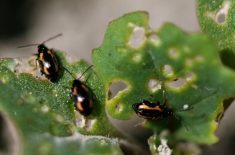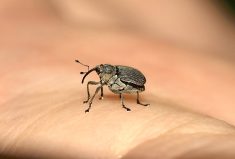Warren Sekulic respects the Pest Management Regulatory Agency, even though its officials knew little about two key pesticides they’re proposing to ban.
“Talking to the PMRA, it was very obvious that it was completely unaware of our farming practices and neonic seed treatments,” said Sekulic, who grows wheat, canola, and peas on his family’s operation near Rycroft.
“It didn’t seem to know our use rates, our volumes, our reasons for use, or how specific seed treatment is in regard to the insects targeted.”
Read Also

New crop insurer policy enables easier startup for faba beans
Agriculture Financial Services Corporation updated its normals for faba beans, which may open the door for more Canadian producers to feel comfortable growing the pulse crop in the future.
The agency announced last summer that it plans to phase out clothianidin and thiamethoxam in the next few years because they harm aquatic insects. That sparked deep concern, especially from canola growers as the two neonicotinoid insecticides are widely used in seed treatments for flea beetles and there are no ready alternatives.
Sekulic, an Alberta Wheat director and Grain Growers of Canada rep, was part of a group that met with agency officials on Nov. 30. By that time, the officials had realized how upset farmers were about the proposed phase-out, he said during a panel discussion at FarmTech.
“They started the meeting wary of what we were going to say,” said Sekulic. “I think they’re very unprepared for the backlash that the neonic file is getting.”
They also may not have expected that the farmers in the meeting would go well beyond a ‘we need this’ pitch and put forward a science-based case for not banning the two neonics.
For example, Sekulic showed them photos on his phone of treated seed and explained that because of seed treatments, he hasn’t used foliar insecticides for years.
“I wanted to show them just how minuscule the margin of exposure is to seed treatments in this — and they asked lots of questions,” he said.
The group also pointed out the agency’s neonic study that examined the environmental threat used small sample sizes. As well, the Eastern Canada weather data used to assess the risks simply doesn’t apply in Western Canada.
Agency overloaded
But the meeting didn’t end with finger pointing — rather, the group offered to assist the agency by bringing it information on how neonics are used. The officials cautiously accepted the offer of help, said Sekulic, and since then both the relationship and communication has improved.
That prompted him and the other two FarmTech panellists to urge audience members to make their voice heard in matters like this.
Producers need to share details with scientists who work in labs all day, said Maria Trainer, managing director of regulatory affairs at CropLife Canada.

“The kinds of things that you do on the farm can be mind blowing to someone like me,” she said. “Just going in and talking to the regulator about what you do and how you do it — that matters and is really important.”
It also helps to understand the work of a body like the Pest Management Regulatory Agency — and the conditions it works under.
Three years ago, the agency was criticized by the federal auditor general for taking too long to cancel registrations of pesticides shown to have unacceptable risks.
“Part of the problem is the PMRA was slammed by an auditor general’s report and it demanded tight timelines and deadlines,” said Sekulic.
But that can be a detriment to good science, he said, suggesting the agency might want to revise its timelines so it doesn’t have to re-evaluate every product every 15 years.
“From what I understand, pharmaceuticals have a slightly different timeline period and are done at longer intervals, until they’re only done if something triggers a special re-evaluation,” he said.
Reviews take a long time, and with about 400 farm chemical products on the market, there’s no way for the agency to review them all, said Trainer.
What often happens is the agency starts re-evaluations with no hope of completing them all on time, she said.
“We mapped out their re-evaluations for the next 20 years,” she said. “By 2028, they will have 358 re-evaluations on the books. They’re only publishing 10 to 15 a year. That’s not a sustainable workload.”
Speaking up
Sekulic would like to see the agency co-ordinate more with the U.S. Environmental Protection Agency when approving new chemistries — and talk more to growers and involve them in the process.
The agency does good work and is committed to science, but there is definitely room for improvement, he said.
“I want a strong, robust regulatory body. It is essential to domestic users and export markets that hazards and risks regarding the chemicals we use are safe.”
But not only is the agency supposed to review products every 15 years, it is also supposed to do a special review whenever a member nation in the Organization for Economic Co-operation and Development deregisters a product that is registered in Canada, said Mark Walker, policy manager with the Canadian Canola Growers Association.

“The issue with this is that it doesn’t matter when the last time it was reviewed,” said Walker.
The canola growers’ association also had concerns with the agency’s science in the proposed neonic ban. So it hired a toxicologist who found issues with its review study, including a small sample size.
The alternatives — or lack of them — also have to be considered, he added.
“If we lose access to these products, we will have to use different chemistries to compensate,” said Walker. “They will have increased costs, increased environmental impacts and that needs to be taken into account if the PMRA is able to do so.”
His organization wants the agency to consider the alternative to a ban, namely ways to mitigate the risk of the neonics getting into water bodies.
But like Sekulic and Trainer, Walker noted the agency is stretched in doing all the reviews on the 15-year schedule.
“It is resource constrained, it is time constrained, so getting there is difficult,” he said.
Walker encouraged producers to weigh in online any time there is consultation about the chemistries they use. In the neonics consultation, farmers’ responses were noticed and were very important, he said.
The threat of the potential loss of pesticides shouldn’t be ignored, said Trainer.
“Pesticides and fungicides are an example of tools we are losing at a rate that far exceeds their replacements,” she said. “If you don’t speak up about what you do, somebody else is going to come in and speak about what you do.”
The agency is currently looking at ways to encourage stakeholder engagement, and farmers should take advantage, she said.
“This is huge. This is a great opportunity to get everyone involved and help fix this issue,” she said.
















